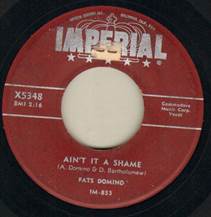The Dodgers defeated the Cubs last night and now will move on to the 2017 World Series. Or, if we must, the “World Series Presented by You Tube TV.” This had to be sweet revenge for the Dodgers who lost the NLCS last year to the Cubs who were on their way to winning their first World Series in 108 years.
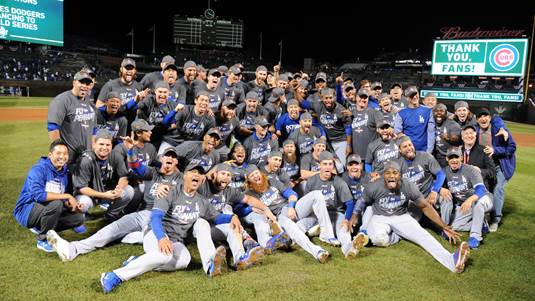
In the American League, the surging Yankees and the Astros play Game 6 of the ALCS tonight. If the Yankees win tonight or tomorrow, the Series matchup will be between the two teams with the highest payrolls. LA’s opening day payroll was $242 million compared to the Yankees $201 million. If the Astros sneak in, it will be with the 18th highest payroll at $124 million. [Royals – $140 million; Cardinals – $152 million]
“Wait Till Next Year” was the mantra of loyal Brooklyn Dodgers fans in the 1940’s and 1950’s. It could also be adopted by the fans of the current version of the Los Angeles Dodgers.
In the fourteen seasons from 1941 to 1954, the Brooklyn Dodgers won five National League pennants. This took them to five World Series. They lost all of them to the New York Yankees. Hence, the annual cry of “Wait Till Next Year.” That year finally came in 1955 when “Dem Bums” beat the Yankees in the Series. The famous headline was “This is Next Year.” Owner Walter O’Malley celebrated by moving the team to LA in 1958.
In the thirteen seasons from 2004 to 2016, the Los Angeles Dodgers have been in the playoffs eight times, seven as the winner of the Western Division and once as a Wild Card. They were eliminated all eight times without reaching the World Series. So 2017 has become “next year” for the Dodgers to reach the Series, but will it also be “next year” to win the Series? They last won it all in 1988, 29 years ago.
To fill out this story, I am bringing back excerpts from two earlier Hot Stoves.
The first is about the Dodgers of Brooklyn, as told in a memoir by Doris Kearns Goodwin who grew up with “Dem Bums.” She tells of the thrill of the Series victory in 1955, soon to be followed by the agony of Walter O’Malley moving the team to Los Angeles in 1958. That move turned Doris into a Red Sox fan.
To give the current Dodgers some credit, they do embrace their Brooklyn heritage. When Rita and I did our California stadium tour this past June, we admired the fine new statue of Jackie Robinson at Dodger Stadium. There is also a memorabilia gallery where due recognition is given to the “Boys of Summer” and that 1955 team that won the Series. One of our photos:
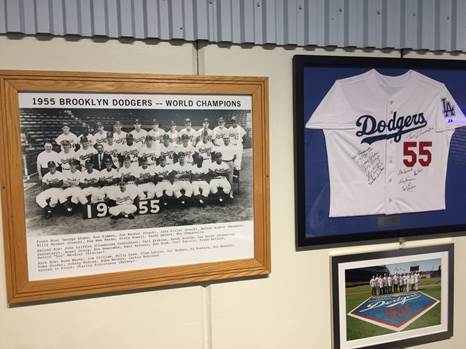
Rita and I will have the good fortune see Doris Kearns Goodwin in November when she speaks at the Truman Institute in Kansas City. At that venue, she will of course be speaking on her day job specialty of presidential history rather than her love of baseball (her Red Sox won the AL East this year, but bowed out in the first round). I’m guessing that she is rooting for anybody but the Dodgers in this year’s Series.
As for the Dodgers of Los Angeles, I rely on sportswriter Molly Knight, starting with her book The Best Team Money Can Buy and continuing with her hilarious Twitter feed. Her book chronicles the eclectic string of Dodger owners, the huge new money from TV and the spending of that money to build a team.
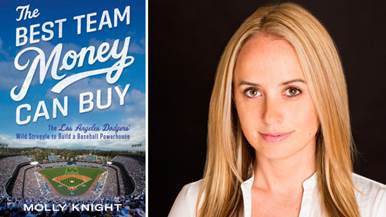
The Dodgers TV contract is integral to the story of today’s team. Time Warner paid billions for the local TV rights, and then found that other cable companies were unwilling to add the high-priced package for their customers. Four years into the contract, about half of Los Angeles still does not have TV access to the games. And this has continued even though “Time Warner is now Spectrum” (the subtle suggestion that the abysmal cable service from Time Warner was left behind).
This week, as the Dodgers headed to Wrigley Field after two wins over the Cubs, Molly wrote this in “The Athletic” blog:
“Hello Chicago! It’s ya girl in Los Angeles who wrote a book on the Dodgers, but who watches the Cubs instead almost every day because the local nine have been blacked out at my house for four years even though I live six miles from Dodger Stadium.”
With Game 3 coming up, she then discussed how Cubs pitcher Kyle Hendricks might be a problem for the Dodgers because “His sinker darts like a squirrel possessed. His changeup can dive away from lefties and cut from righties.” But she thought Dodger pitcher Yu Darvish could be even better because he “is confusing as Ikea furniture instructions, and he comes with as many cumbersome parts.” Darvish did indeed get the best of Hendricks as the Dodgers won Game 3 by a score of 6-1.
Molly also had some choice words about Cubs manager Joe Maddon who led the Cubs against the Dodgers in the NLCS in both 2016 and 2017:
“But his in-game strategery has been exposed two Octobers in a row. He was out-foxed by Dave Roberts and Terry Francona last year, but the Cubs won the World Series anyway by out-talenting everyone. He’s getting pantsed by Roberts again this year, so his players will have to pick him up. Clearly, they are capable of doing just that. The Cubs have most of the same players from a year ago, minus the domestic abuser now in New York. They’re rested, they’re back home, and they’ve got their real ace on the mound. If they win Tuesday, this series is wide open. If they lose, hey, as Cubs fans have long said, there’s always last year.”
Did you catch the twist at the end of the quote? “Cubs fans have long said, there’s always last year” – a reverse of the old cry “Wait Till Next Year.” I know the feeling as we Royals fans now often say “We’ll always have 2015.”
The Cubs avoided a sweep by winning Game 4 with the help of a 6-out save by Wade Davis. But Game 5 was all Dodgers with pitcher Clayton Kershaw at his best and Enrique “Kiké” Hernandez hitting three homers to lead the Dodgers to an 11-1 victory and the National League pennant.
So Molly’s Dodgers are headed to the You Tube TV World Series. How long has it been since the last one? After last night’s game, Molly tweeted this photo of her first day of school in 1989. She is wearing her Blue Crew hat which has a 1988 World Series pin that she got at her first Dodger game. Who could deny this child a second pin? Or for that matter, the woman in the photo above.
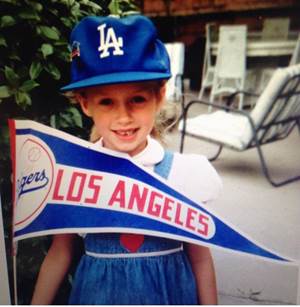
From Hot Stove #35 (3/2/17) – Wait Till Next Year: A personal memoir by Doris Kearns Goodwin, one of my favorite storytellers. She is best known as a presidential historian with books on Lyndon Johnson, the Kennedys, the Roosevelts and Abraham Lincoln (Team of Rivals). I have had the good fortune to see her twice in person – at a Rainy Day Books event and at a law firm retreat. As a raconteur, she is mesmerizing. Rita was recently browsing through our stacks of books and found a gem that we had not read, that rare Goodwin book not about a president. It is about growing up as a baseball fan. I don’t how we missed reading this earlier – it was published in 1997. Our assessment: Great Book!
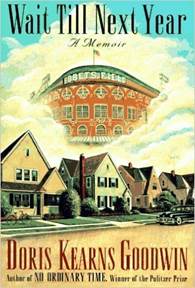
Goodwin grew up in Long Island where baseball loyalties were divided among Yankee, Dodger and Giant fans. Her father was an avid Dodger fan who as a boy attended the first game at Ebbets Field in 1913. The Dodgers saw some success with pennants in 1916, 1920, 1941 and 1947 (Jackie Robinson’s first season), but they lost the World Series each time.
In 1949, six-year old Doris started her immersion into baseball when her father gave her a bright red scorebook. “Night after night he taught me the odd collection of symbols, numbers, and letters that enable a baseball lover to record every action of the game…By the time I had mastered the art of scorekeeping, a lasting bond had been forged among my father, baseball, and me.” That summer, she listened to sportscaster Red Barber on her Philco radio and recorded every play using her father’s scoring system. When her father came home from work, she got out her scorebook and recounted the game for him, play-by-play. A storyteller was born.
The 1949 season was a good time for her to start. The Dodgers won the pennant. Doris made her debut trip to Ebbets Field that summer and witnessed another first – the first black pitcher and batter to face each other in a game (Don Newcombe pitching to Hank Thompson of the Giants). She also learned the agony of defeat. The hated Yankees won the World Series. In 1950, Vin Scully joined Red Barber in the broadcast booth. What a way to listen to baseball. Vin stayed for another 66 years.
In 1951, the Dodgers were on their way to a pennant when they collapsed and were forced into a three-game playoff with the Giants that ended with Bobby Thomson’s walk-off homer. Doris was watching the game on TV and remembers the “never-to-be-forgotten” voice of announcer Russ Hodges repeatedly shouting that the Giants had won the pennant. “I threw down my scorebook, the last page never to be completed…It was the worst moment in my life as a fan, worse even than any loss to the Yankees in the World Series.”
Not that it was fun to lose to the Yankees. The Dodgers came back to win pennants in 1952 and 1953, only to lose the Series to the Yankees – for the fifth time in a row dating back to 1941. This brought the all-time Dodgers record in the World Series to 0 and 7. By then, the long suffering fans had adopted the slogan “WAIT TILL NEXT YEAR.” Hence, the title of Goodwin’s book. Even with the Dodger heartbreaks, she knows it was a golden era for a baseball fan in New York.

“For all of us, the love was personal and familiar. We spent hours arguing about whether Duke Snider, Willie Mays, or Mickey Mantle was the best center fielder. The handsome smooth-fielding Duke Snider was the most consistent home-run hitter of the three, but Mays had a balletic grace and joyful fury, while the switch-hitting Mantle had the greatest raw power and speed. Who was the best announcer: Russ Hodges, Mel Allen or Red Barber? Who was the better catcher: Roy Campanella, steady behind the plate, unequaled in calling pitches, but a streaky hitter, or the short-armed swarthy Yogi Berra, the most dangerous hitter in baseball in late innings? Was Pee Wee Reese, the “Little Colonel,” who held the Dodgers together, a better shortstop than Phil Rizzuto, who led the American League in fielding? And which team had a better double-play combination: the Dodgers with Reese and Robinson, or the Giants with Alvin Dark and Eddie Stanky, whom we called “Eddie Stinky”? For support, we each mustered our own statistics and anecdotes. We carried out our arguments on the street and, and in the corner stores, and in each other’s homes. If no minds were changed, we took great pleasure in our endless debates and our shared love for the sport.”
In 1955, the Dodgers led the National League every day of the season. Doris went to a game with her dad in July and Jackie Robinson signed her autograph book (“Keep your smile a long, long while. Jackie Robinson.”). After winning the pennant, the Dodgers were again facing the dreaded Yankees. But this time, “Dem Bums” won the World Series. Doris was in school, but got home in time to see Johnny Podres complete his shutout to give the Dodgers their first-ever World Series victory.
The front page headline said it all:
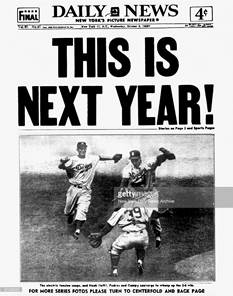
The celebration was short lived. The 1955 World Series would be both the first and last won by the Brooklyn Dodgers. They returned to the Series in 1956, but the Yankees got their revenge, including Don Larsen pitching his perfect game. The Dodgers played only one more season at Ebbets Field before Walter O’Malley moved the team to Los Angeles. The Goodwin family baseball loyalty did not transfer to La La Land. Years later, while working on her doctorate at Harvard, Doris went to a game at Fenway Park and found a new team to love. But the Red Sox had a familiar flaw – they could not seem to win a World Series. “Nor could I have found a team more reminiscent of the Brooklyn Dodgers than my new team, the Boston Red Sox. Perpetual bridesmaids, exciters of hope and destroyers of dreams.”
Boston’s last win in the World Series had been in 1918 when pitcher Babe Ruth won two games for the Sox. Ruth was traded to the Yankees after the 1919 season, and the Curse of the Bambino began its run in Boston. Goodwin saw her Red Sox win pennants in 1967, 1975 and 1986, only to lose the World Series each time. She ends her book with the 1986 Series loss that is famously remembered for the easy grounder that went through Bill Buckner’s legs. By then, she was taking her sons to the games and had taught them how to keep score. She watched the end of that Series with her sons: “As I sat in front of the television set in tears after the Sox lost the final game, my two youngest boys rushed to console me. ‘Don’t worry, Mom, they’ll win next season’.” You know, wait till next year.
[She waited through 18 more next years. Finally, in 2004, “This is Next Year” came for the Red Sox and they won their first World Series since 1918. To prove it was not a fluke, they repeated in 2007 and 2013.]
From Hot Stove #37 (4/1/17) – The Best Team Money Can Buy: By Molly Knight (2015). On a recommendation from Leland Shurin, I read this fascinating tale of how money drives baseball and why the $2.15 billion purchase price for the Dodgers in 2012 turned out to be a bargain.
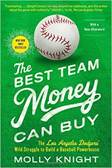
The subtitle of the book is The Los Angeles Dodgers’ Wild Struggle to Build a Baseball Powerhouse. “Wild” would certainly describe Frank McCourt who owned the Dodgers from 2004 to 2012. The O’Malley family had owned the Dodgers for over 50 years, and Walter O’Malley made two of the key moves in baseball history: he brought Jackie Robinson to the major leagues in 1947 and he relocated the Dodgers from Brooklyn to LA in 1958. In 1998, the O’Malley family sold the club to Rupert Murdoch’s Fox Entertainment Group who in turn sold it to Frank McCourt in 2004. Fox wanted out so much that they loaned a good portion of the $371 million purchase price to McCourt who put little equity in the deal.
McCourt and his wife Jamie jumped into the glamour of owning a team in LA. Jamie became CEO. They bought many homes and lived the high life, but the big loans for the team were not getting paid down fast enough. McCourt’s ace in the hole was that the team’s TV rights would be coming up for renewal and would bail him out of any problems. But not soon enough. Frank and Jamie grew to dislike each other, and Jamie filed for divorce in 2009. The team ended up in bankruptcy for reorganization. After nasty litigation that is believed to be the costliest divorce in California history, Jamie settled for $131 million for her half interest in the Dodgers. A few months after that, under pressure from Commissioner Bud Selig, Frank sold the Dodgers at auction. He got $2.15 billion, quite a nice profit for Frank. Jamie was not happy, calculating that she came out about $900 million short for her share. It did not help that Frank was very publicly displaying new eye candy (another woman) at sporting events. Jamie sued to set aside her settlement, but the appeals court said no.
[Baseball Owner Divorce Trivia – The McCourt divorce has at least one predecessor in baseball history. Bill Veeck met the same fate with his Cleveland Indians after the team won the World Series in 1948. The Indians did not repeat in 1949, but the team still had good value and Veeck needed cash to fund his divorce settlement. After selling the Indians, he later owned the St. Louis Browns and Chicago White Sox.]
The New Owners – Receiving Big Dollars from TV: Jamie McCourt was not the only one surprised by the purchase price for the team. The prior top price for a pro franchise had been $1.1 billion for the NFL Miami Dolphins in 2009. Forbes magazine had estimated the Dodgers value at $900 million. The new owners, a group assembled by Guggenheim Partners (including Magic Johnson), shared Frank McCourt’s view that a new TV deal would close any gap. And it did, big time. In 2013, the Dodgers signed a 25-year deal with Time Warner for $8.3 billion. [The TV deal has not worked out well for TW. Other cable carriers objected to the TW rates and refused to carry the games. In 2016, the last year for announcer Vin Scully, 60% of the LA cable market did not get the games.]
The New Owners – Paying Big Dollars to Players: Time Warner paid too much, but the Dodgers are not giving it back – they are spending it on players. When the new owners bought the team on May 1, 2012, the payroll for that season was already set at $105 million. The owners quickly made up for that by doubling the payroll for 2013. Molly Knight’s book covers the 2013 and 2014 seasons, and she focuses on two players to show how the Dodgers are escalating salaries to build a baseball powerhouse. Clayton Kershaw signed a 7-year deal for $215 million, the richest ever for a pitcher. Rookie phenom Yasiel Puig was signed as a free agent out of Cuba for $42 million in another 7-year deal. Kershaw won the Cy Young in 2013 and 2014, and Puig was a hitting and fielding sensation. But…
Puig was a distraction with his tardiness and entourage. Other teams found him arrogant. The clever title to the Puig chapter in Knight’s book is “Puigatory.” Kershaw was great in the regular season, but he faltered in the NLCS in 2013 and the NLDS in 2014, each time losing two games. The question of team chemistry was raised, as it always is when payroll is high and the team loses in the postseason. The Dodgers last won a World Series in 1988. The Giants have a payroll of about $100 million less than the Dodgers, but won the World Series in 2010, 2012 and 2014, arguably because of a better clubhouse culture.
[Update after Knight’s book: The Dodgers bumped their payroll in 2015 to $271 million, easily the highest in the major leagues. Kershaw pitched well in the 2015 NLDS, but the Dodgers lost to the Mets who went on to play the Royals in the World Series. In 2016, Kershaw lost the final game in the NLCS to the Cubs who went on to win the World Series. Puig was plagued by injuries in 2015 and 2016 and was not a factor. And now in 2017, maybe glory.]
Lonnie’s Jukebox: While the Brooklyn Dodgers were winning the NL pennant and heading to the World Series in 1955, some of the earliest rock ‘n’ roll stars had their first top-10 hits: Chuck Berry (“Maybellene”), The Platters (“Only You”), and Fats Domino (“Ain’t That a Shame”). I entered Van Horn High School that fall, and my 45-rpm record collection was growing, including having each of these three records. Fats was a big favorite of mine, and I wisely purchased his version rather than the lame cover by Pat Boone. Fat’s record label carries a mistake in the song title with “That” being replaced by “It” (see below). As you will hear at this link, Fats sings “Ain’t THAT a Shame.” My baseball metaphor for this song is the Dodgers leaving Brooklyn for Los Angeles: “You [Dodgers] made me cry when you said goodbye,”/“Ain’t That a Shame”/“You’re the one [Walter O’Malley] to blame.”
